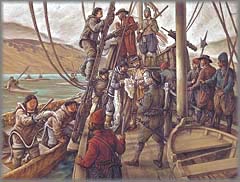
|
 robisher went ashore on an island, and for the first time saw signs that the country was inhabited. robisher went ashore on an island, and for the first time saw signs that the country was inhabited.
|
"And being ashore, vpon the toppe of a hill, he perceiued a number of small things fleeting in the Sea a farre off, whyche hee supposed to be Porposes, or Ceales, or some kinde of strange fishe: but comming nearer, he discouered them to be men, in small boates made of leather."
(George Best's account of the 1576 voyage)

|
|
Frobisher met the Inuit of Baffin Island. Over the next days the two groups cautiously traded with one another, sometimes ashore and sometimes aboard the Gabriel. The Inuit appeared familiar with ships such as this; they tried European food, drank wine, and competed with the mariners in acrobatics on the ropes of the ship's rigging.
|
 |

First Contact
By Francis Back
 |
|
"They exchanged coates of Ceale, and Beares skinnes, and suche like, with oure men, and receiued belles, loking glasses, and other toyes in recompence thereof againe."
(George Best's account of the 1576 voyage)

|
|
The English had never encountered such people and marvelled at their appearance. Christopher Hall, skipper of the Gabriel, described them as follows:
|
"They bee like to Tartars, with long blacke haire, broad faces, and flatte noses, and tawnie in colour, wearing Seale skinnes, and so doe the women, not differing in the fashion, but the women are marked in the face with blewe streekes downe the cheekes, and round about the eyes."
(Christopher Hall's account of the 1576 voyage)

|
|
The English hired one of their new Inuit acquaintances to pilot them through the islands to the west. From this situation arose the unfortunate incident of the five lost sailors, which poisoned relations between the two peoples.
|


|

